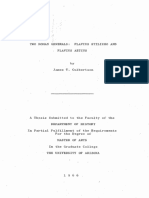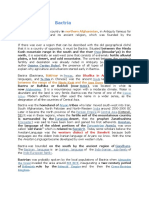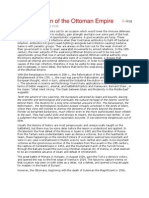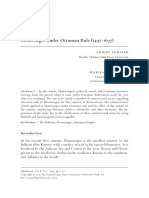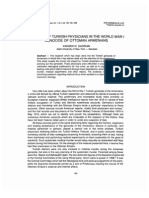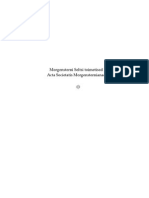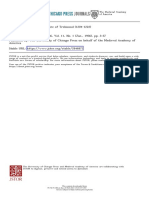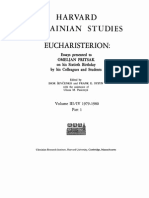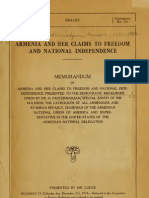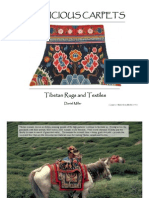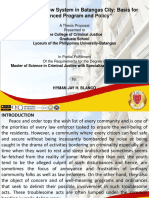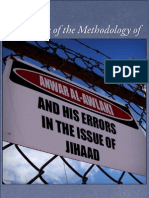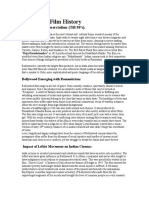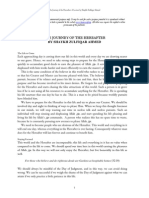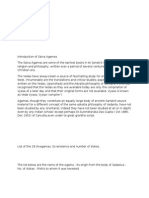Professional Documents
Culture Documents
Slaveasteurorev2 95 3 0401
Uploaded by
Okan Murat ÖztürkOriginal Description:
Original Title
Copyright
Available Formats
Share this document
Did you find this document useful?
Is this content inappropriate?
Report this DocumentCopyright:
Available Formats
Slaveasteurorev2 95 3 0401
Uploaded by
Okan Murat ÖztürkCopyright:
Available Formats
Cultural Hybridity in the Religious Literature of the Tatars of North-Eastern Europe
Author(s): Shirin Akiner
Source: The Slavonic and East European Review , July 2017, Vol. 95, No. 3 (July 2017), pp.
401-428
Published by: the Modern Humanities Research Association and University College London,
School of Slavonic and East European Studies
Stable URL: https://www.jstor.org/stable/10.5699/slaveasteurorev2.95.3.0401
REFERENCES
Linked references are available on JSTOR for this article:
https://www.jstor.org/stable/10.5699/slaveasteurorev2.95.3.0401?seq=1&cid=pdf-
reference#references_tab_contents
You may need to log in to JSTOR to access the linked references.
JSTOR is a not-for-profit service that helps scholars, researchers, and students discover, use, and build upon a wide
range of content in a trusted digital archive. We use information technology and tools to increase productivity and
facilitate new forms of scholarship. For more information about JSTOR, please contact support@jstor.org.
Your use of the JSTOR archive indicates your acceptance of the Terms & Conditions of Use, available at
https://about.jstor.org/terms
Modern Humanities Research Association and University College London, School of Slavonic and
East European Studies are collaborating with JSTOR to digitize, preserve and extend access to The
Slavonic and East European Review
This content downloaded from
78.175.231.243 on Fri, 08 Apr 2022 19:24:20 UTC
All use subject to https://about.jstor.org/terms
Cultural Hybridity in the
Religious Literature of the
Tatars of North-Eastern Europe
SHIRIN AKINER
The religious literature of the Tatars of north-eastern Europe (Belarus,
Lithuania and Poland), produced by Muslims of Turkic origin in a
Christian-Slav environment, is an intriguing example of cultural hybridity.
Despite living far from their original homeland, and with limited contact
with the world of Islam, they succeeded in preserving a unique cultural
identity for over eight centuries. Some minority communities seek to
preserve their heritage by distancing themselves from the ‘main stream’,
limiting the degree to which they interact with the dominant culture. The
Tatars of north-eastern Europe, however, kept alive their unique identity
by a combination of adaptability to the customs and norms of their
adopted homeland, while at the same time preserving their own traditions;
thus, they embraced change but maintained continuity in their social
customs and above all, in their practice of Islam. The religious literature
that they created bears witness to this eclectic intermingling of cultural
and linguistic influences. In order to set this literature in context, this
article starts with a brief historical introduction, looking at such issues as
the socio-linguistic diversity of the Tatar settlers; the political upheavals
in their new homeland; and the changing religious environment. This is
followed by an overview of the genres that characterize the Tatar religious
literature. Finally, two ‘exotic’ narratives are examined, one taken from
an Arabic source, the other from a Biblical text that reveals Protestant
sectarian influence.
Shirin Akiner is a Research Associate in the Department of the Languages and Cultures of
Near and Middle East at the School of Oriental and African Studies.
Belarusian references in this paper are given in the standard SEER transliteration of
Cyrillic; this differs somewhat from the Latin alphabet used for modern Belarusian.
Slavonic and East European Review, 95, 3, 2017
This content downloaded from
78.175.231.243 on Fri, 08 Apr 2022 19:24:20 UTC
All use subject to https://about.jstor.org/terms
402 SHIRIN AKINER
Historical background
The history of the Tatars of the Grand Duchy of Lithuania can be traced
back to the early thirteenth century, to the high plateaux of inner Asia
(approximately corresponding to modern Mongolia). It was from here
that in 1207 Chingiz Khan embarked on a series of campaigns across great
swathes of Europe and Asia. Within scarcely more than a decade, his army
of Mongols and Turkic Tatars had conquered an empire that extended
from China to central Europe, from Siberia to the Middle East. When he
died (1227), this vast state was divided into semi-autonomous appanages,
each headed by one of his sons or grandsons. The westernmost territories
eventually developed into an independent entity commonly known as the
Golden Horde, with its capital on the lower Volga.1 It was ruled by Mongol
princes of the Chingiscid line, but the population was predominantly
Turkic. In European and Middle Eastern sources of the time the terms
‘Tatar’ and ‘Mongol’ were used interchangeably, although linguistically
and anthropologically they denote different groups.2 Gradually, the term
‘Mongol’ was dropped and ‘Tatar’ became the common designation for all
the peoples of the Golden Horde.
The Tatars, like other steppe peoples, originally practised various
forms of nature worship. However, after settling in the Volga region
they began to adopt Islam and in the early fourteenth century, the entire
Golden Horde was converted to Islam.3 Moreover, with the acceptance of
Islam, the Arabic script was adopted in place of the Uighur script that had
been used since the time of Chingiz Khan. There was no unified literary
language in the Golden Horde. The dominant languages were various
forms of Turkic: Kipchak, Khwarezmian, Chagatai and Karakhanid.
The differences between these languages are reflected in the distinctive
characteristics of Nogai, Volga Tatar, Bashkir and the other languages that
later developed on the territory of the Golden Horde.4
1
There is an extensive literature on the Mongol Empire. Important studies include B.
D. Spuler, Die Goldene Horde: Die Mongolen in Russland 1223–1502, Wiesbaden, 1943, pp.
264–70; B. D. Grekov and A. Ju. Jakubovskij, Zolotaja orda i jejo padenie, Moscow and
Leningrad, 1950, pp. 141–55; G. Seaman and D. Marks (eds), Rulers from the Steppe: State
Formation on the Eurasian Periphery, Los Angeles, CA, 1991, pp. 255–73.
2
The Tatars are a Turkic-speaking people; the Mongol language belongs to the quite
separate Mongolic language group.
3
D. DeWeese, Islamization and the Native Religion in the Golden Horde, Pennsylvania,
PA, 1994, pp. 90–142.
4
For the classification of the Turkic languages, see J. Deny et al. (eds), Fundamenta
Philologiae Turcicae, 1, Wiesbaden, 1969.
This content downloaded from
78.175.231.243 on Fri, 08 Apr 2022 19:24:20 UTC
All use subject to https://about.jstor.org/terms
TATAR RELIGIOUS LITERATURE 403
The Golden Horde was a powerful military force, but internally it
was weak, racked by feuds between rival princes.5 In the early fourteenth
century, small groups of Tatar-Mongols began to move to north-eastern
Europe, where they settled in the Grand Duchy of Lithuania (which
encompassed much of the territory of modern Belarus, Lithuania and
Poland). The Grand Duchy was still a relatively young state. As it expanded,
it came into conflict with neighbouring powers: the Teutonic Knights,
the Russian principalities and later the Crimean Khanate. Thus, it was
imperative to have a strong army. The Tatars, who were renowned for their
fighting skills, provided an important addition to the forces of the Grand
Duchy.6 The influx of Tatars from the Golden Horde continued for some
two hundred years, up to the early sixteenth century. By this time there was
a sizeable community of Tatar settlers in the Grand Duchy; estimates of
numbers vary wildly, from a few thousand to hundreds of thousands.7 The
Golden Horde, torn apart by internecine strife, gradually disintegrated into
smaller units such as the Khanates of the Crimea, Astrakhan and Kazan´.
The Tatars who settled in the Grand Duchy were a heterogeneous social
group. Some were of high status, proudly claiming direct lineal descent
from Chinghiz Khan. The majority, however, were common foot soldiers
and camp followers. They were ethnically mixed, coming from different
tribes and speaking different dialects. Some Tatars moved to the territory
of the Polish Crown, where a number of them adopted Christianity. The
majority, though, settled in the Grand Duchy. One of their main centres
was Troki (modern Trakai); Haji Girey, future founder of the Crimean
Horde, was born here (c.1470), as was at least one of his sons.8 They were not
the only foreigners: the Grand Duke Vitoldus 9 encouraged immigration
5
M. Stryjkowski, Kronika Polska, Litewska, Żmódzka i Wszystkiej Rusi, 1, Warsaw,
1846, p. 360.
6
A. W. Koialowicz, Historiae Lituaniae Pars Prior, Gdansk, 1650, p. 248.
7
In Risâle-i Tatar-i Leh (Treatise on the Tatars of Poland), a report dated 1558,
purportedly composed in Istanbul by a Tatar pilgrim, it was claimed that the Tatar
population at that time numbered 200,000. A Polish translation of this manuscript was
published by A. Muchliński as ‘Zdanie sprawy o Tatarach litewskich’, in Teka wileńska,
4, Vilna, 1858, pp. 241–69 (p. 263). Later historians, notably S. Kryczyński, dismissed this
figure as the ‘Oriental tendency to exaggeration’ and estimated that, at most, there were
some 3,000 to 4,000 Tatars (Rocznik Tatarski, 3, Warsaw, 1938, p. 23).
8
S. Akiner, Religious Language of the Belarusian Tatars: A Cultural Monument of Islam
in Europe, Wiesbaden, 2009, p. 27.
9
The official state language of the Grand Duchy was ‘Ruthenian’ (in this context
meaning ‘Old Belarusian’), and the ruler was styled Rex Litvinorum Ruthenorumque. In
documents of the time, depending on the language of the text, his name was given in
the respective Belarusian, Polish or Latin forms, i.e. Vytaut/Witołd/Vitoldus. In modern
histories the Lithuanian form Vytautas is usually preferred. Here, to avoid anachronisms
This content downloaded from
78.175.231.243 on Fri, 08 Apr 2022 19:24:20 UTC
All use subject to https://about.jstor.org/terms
404 SHIRIN AKINER
and granted incomers freedom of religion and a wide range of civic rights.
In addition to the native Slavs (modern Belarusians) and Lithuanians, the
population of the Grand Duchy during this period included colonies of
Germans, Orthodox Jews and Karaites (a Turkic-speaking Jewish sect from
the Crimea who rejected rabbinical traditions and laws).10 The Tatars had
a number of special privileges: they were not only allowed to profess their
Islamic faith, but were also given the right to marry local women and to
have the children of such unions brought up as Muslims.
In 1569, Lithuania and Poland, already united by a personal union
between their rulers (1385, Union of Krewo), formed the federated Polish-
Lithuanian Commonwealth (PLC). This coincided with a period of religious
ferment, marked by fierce doctrinal struggles between proponents of the
Protestant Reformation and the Roman Catholic Counter-reformation.11
It was also a time when Ottoman power was expanding rapidly, and
the PLC was regarded as the bulwark (antemurale) of the Christian
world against the Ottoman Turks. The Muslim Tatars, like other ethnic
and religious minorities, suffered discrimination and some persecution
during this period. In the early seventeenth century and again during
the Lipka rebellion (1671–76), there was considerable Tatar migration to
the borderlands of the Ottoman Empire (figures are disputed, but it was
probably under five thousand).
The situation improved for a while under Jan Sobieski III (1674–96).
However, during the eighteenth century the PLC was fatally weakened
by a combination of dynastic struggles and foreign wars. It ceased to
exist after the imposition of a series of partitions (1772–95), as a result
of which its territory was divided between Russia, Austria and Prussia.
Most of the areas in which the Tatars were settled came under Russian
rule.12 There was another outflow of Tatars during these years. Some
as well as nationalist controversies, the Latin form is used.
10
The historical origins of Karaites (Karaim) are shrouded in myth. All that is known
for certain is that by the fourteenth century they were living in the Crimea, which at
that time was part of the Golden Horde. According to Karaite tradition, in 1392 Grand
Duke Vitoldus, in alliance with one of the rebel Tatar princes, captured a large number of
prisoners. Among them were 483 Karaite familes. He settled them in the Grand Duchy,
mostly in Troki (Trakai), where there was already a large Tatar settlement. See further N.
Schur, History of the Karaites, Frankfurt am Main, 1992, p. 107.
11
A lively, well-documented study of these debates is given by A. Luto-Kamińska,
‘Features of the Sixteenth Century Religious Polemic Discourse (Exemplified by the Way
Religious Adversaries were Called)’, in D. Jensenova and P. Illikova (eds), Lidská zkušenost
jako součást jazykové sémantiky, Olomouc, forthcoming.
12
A comparative study of the legal status and leadership of Islamic minorities under
Russian rule is given by A. Zhelyazkova and E. Račius (eds), Islamic Leadership in the
This content downloaded from
78.175.231.243 on Fri, 08 Apr 2022 19:24:20 UTC
All use subject to https://about.jstor.org/terms
TATAR RELIGIOUS LITERATURE 405
went to the Ottoman Empire, some to other parts of the Russian Empire;
a few went further afield, to western Europe and even to America. By the
turn of the century, the Tatar community still living on the territory of
the former PCL numbered around 6,000.13 Yet despite all the upheavals,
they continued to practice their Muslim faith, preserving some degree of
communal identity.14
There were further wars, revolutions and territorial divisions in this
region in the twentieth century. Consequently, Tatar communities were
frequently divided and re-divided by international borders. The entire
local population during these years experienced war, revolution, enemy
occupation and deportations, as well as severe economic and social
deprivation. Communities were dispersed, cultural artefacts lost and places
of worship closed. Tatar religious and intellectual leaders disappeared,
some through emigration, others owing to political repression. It seemed
as though this small ethno-religious minority would finally lose its
distinctive identity and merge with the majority population.
Yet towards the end of the twentieth century there were signs of a
cultural and religious revival. There was also renewed scholarly interest
in the history, culture and literature of the Tatars. Both trends continued
after the disintegration of the socialist bloc and the establishment of the
independent states of Belarus, Lithuania and Poland. One of the results
of these changes was that more attention was paid to recovering and
cataloguing Tatar manuscripts. In the 1960s, only some thirty manuscripts
had been traced, but thereafter many more came to light.15 New discoveries
European Lands of the Former Ottoman and Russian Empires (Legacy, Challenges and
Change), forthcoming, 2017. See also E. Račius and T. Bairašauskaitė, ‘Lithuania’ and A.
Nalborczyk, ‘Poland’, in I. Svanberg and D. Westerlund (eds), Muslim Tatar Minorities in
the Baltic Sea Region, Leiden, 2016 (pp. 21–45 and pp. 46–63 respectively). Unfortunately,
this excellent volume does not include the Tatars of Belarus, on the grounds that they do
not live in the Baltic region, although they are part of the same diaspora and, until the late
twentieth century had a common history.
13
This is an approximate (and of course disputed) estimate of population numbers in
the period before the First World War. For a more detailed history of the Tatars in this
region see Akiner, Religious Language, pp. 11–69.
14
A. Konopacki, Życie religijne Tatarow na ziemiach Wielkiego Księstwa Litewskiego w
XVI–XIX wieku, Warsaw, 2010, gives an excellent study of the institutions and customs of
the Tatars in the Grand Duchy when the community was at its height.
15
Descriptive catalogues of Tatar manuscripts include: A. Drozd, M. Dziekan and
T. Majda (eds), Piśmiennictwo i muhiry Tatarów polsko-litewskich: Katalog zabytków
tatarskich, 3, Warsaw, 2000; G. Miškinene, S. Namavičjute and E. Pokrovskaja, Katalog
arabskoalfavitnych rukopisej litovskich Tatar, Vilnius, 2005; T. Samajluk, L. Doŭnar and
T. Dziemianovič (comps), Rukapisnyja i drukavanyja knihi Belaruskich Tataraŭ: Kataloh
vystavy (da 600-hodźdzja asadnictva na Belarusi), Minsk, 1997 (with material from private
This content downloaded from
78.175.231.243 on Fri, 08 Apr 2022 19:24:20 UTC
All use subject to https://about.jstor.org/terms
406 SHIRIN AKINER
continue to be made. This has greatly widened the range of material
available for study.
Creating a religious literature
As indicated above, the Tatars of the Polish-Lithuanian Commonwealth
were a diverse group. The bond that held them together, and enabled them
to maintain a sense of identity, was their Islamic faith. The areas in which
they were settled straddled the language divide between Belarusian and
Polish. By the sixteenth century, most Tatars had forgotten their native
language(s) and spoke only Belarusian and/or Polish.16 This, in addition
to geographic and political constraints, meant that they were increasingly
isolated from the wider Muslim world. Hence, they came to realize that it
was important to create their own religious literature in order to record,
and also to hand on, the essentials of their faith. This meant translating
selected religious works into Belarusian and/or Polish (or more accurately,
into a mixture of Polonized Belarusian and Belarusianized Polish). It is
possible that this process began in the sixteenth century. However, there
is no record of this; extant texts date from a later period, mostly the
nineteenth century.
The most distinctive feature of these manuscripts is that the Slav texts
are written in the Arabic script. Throughout the Muslim world the Arabic
script is revered as the script in which the holy Quran was transcribed.
It was natural, therefore, that the Tatars should wish to use it for their
religious literature. Consequently, they devised a graphic system that used
Arabic letters (modified, where necessary) to convey the phonology of
the Slav languages. Since they were not constrained by the conventions
collections); I. Gančarova, A. Citavjec and M. Tarelka (comps), Rukapisy Belaruskich
Tataraŭ kanca XVII — pačatku XX stahodźdzja: Z kalekcyi Centralnaj navukovaj
biblijateki Nacyjanalnaj akademii navuk Belarusi, Minsk, 2003; Ž. Būčys (comp.), Seraya
Szapszal’s Karaim Collection, Lietuvos nacionalinis muziejus, Vilnius, 2003, pp. 129–33.
Recent additions to the field are: M. Tarelka and A. Citavjec (comps), Rukapisy tataraŭ
Belarusi kanca XVII–pačatku XX stahodźdzja z dzjaržaŭnych knihazboraŭ krainy. Kataloh,
Minsk, 2011 (covers holdings of more institutions than the previous catalogue by the same
authors, mentioned above), and M. Tarelka (comp.), Rukapisy tataraŭ Belarusi XVIII —
pačatku XXI stahodźdzja z dzjaržaŭnych i hramadskich knihazboraŭ krainy, Kataloh,
Minsk, 2015 (describes new additions to state collections, also provincial holdings from
towns such as Navahrudak); G. Miškinene, ‘Katalog arabografičnych rukopisej litovskich
tatar: Britanskaja biblioteka i Belorusskij muzej im. F. Skoriny v Londone’, Litteraria
Copernicana: Tatarzy polscy, 2, 2016, 18, pp. 53–67 (p. 65 gives additional bibliographic
details of catalogues of collections in Grodna, L´vov/Lviv and Kazan´).
16
Contemporary accounts by foreign travellers give valuable information on this issue.
See, for example, J. Boemus, Repertorium librorum de omnium gentium ritibus, Augustae
Vindelicorum (Augsburg), 1520, f. xlviii.
This content downloaded from
78.175.231.243 on Fri, 08 Apr 2022 19:24:20 UTC
All use subject to https://about.jstor.org/terms
TATAR RELIGIOUS LITERATURE 407
of an inherited orthographic tradition, they were able to record the living
language as they heard it, including dialectal peculiarities of pronunciation
and syntax.
The Tatars also created a religious vocabulary that was suited to the
expression of Islamic ideas.17 For general ethical concepts they drew on
Belarusian and Polish, but for terms relating to Islamic doctrine and
practice they used Arabic loanwords, ‘Slavicizing’ them morphologically
and phonetically.18 In most texts there are inserted quotations from Arabic
and Ottoman Turkish. However, such passages are often grammatically
and orthographically inaccurate (‘a shockingly illiterate mix of semi-
Arabic, semi-Tatar’, as one scholar put it), indicating that the scribe was not
well versed in these languages.19
Literary genres
The religious literature of the Tatars comprises different formats, ranging
from pious inscriptions on decorative wall plaques and gravestones,
to book-length compositions. There are four main genres in the latter
category:
tefsir (Ar. tafsīr ‘explanation’, ‘exegesis’): the text of the whole Quran in
Arabic, with interlinear translation (or paraphrasing) into Belarusian/
Polish; the translations were probably made from Ottoman Turkish
glosses rather than from the original Arabic.20
chamail (from Ar. ۊamala ‘to carry’): collections of prayers and pious
narratives, also spells, incantations and recipes for curing sickness;
usually quite small in format, carried by the owner and consulted daily.
The language is predominantly Belarusian/Polish, with quotations in
Arabic or Ottoman Turkish.21
17
J. Kulwicka-Kamińska, Przekład terminologii religijnej islamu w polskich
tłumaczeniach Koranu na tle biblijnej tradycji translatorycznej, Toruń, 2013, presents a
comparative study of Islamic and Biblical terminology in translation.
18
Akiner, Religious Language, pp. 110–16.
19
I. Ju. Kračkovskij, ‘Rukopis’ Korana v Pskove’, Izbrannyje sočinenija, 1, Moscow and
Leningrad, 1955, pp. 162–65 (p.163).
20
J. Szynkiewicz, ‘Literatura religijna Tatarów litewskich i jej pochodzenie’, Rocznik
Tatarski, 2, Zamość, 1935, pp. 138–44 (p.141). Szynkiewicz (b. 1884, Ljachavičy – d. 1966,
Waterbury CT) was elected Mufti of independent Poland, the first person to hold this post.
An erudite Quranic scholar, he was also versed in Turkic and Arabic Islamic literature and
was thus well qualified to study the Tatar religious literature.
21
Some researchers have identified traces of Uighur and other Turkic languages.
See A. Zajączkowski, ‘Tak zwany chamaił tatarski ze zbioru rękopisów w Warszawie’,
Sprawozdania z czynności i posiedzeń Polskiej Akademii Umiejętności, 52, 1952, 4, Cracow
This content downloaded from
78.175.231.243 on Fri, 08 Apr 2022 19:24:20 UTC
All use subject to https://about.jstor.org/terms
408 SHIRIN AKINER
dalawar/dualary/dwalary (Ar. du’ā ‘prayer’ + Turkic plural suffix -lar
+ Slav. plural suffix -y): prayers for personal use in Arabic or Turkish,
often rolled up in the form of scrolls; traditionally, they were placed in
the grave with the deceased.22
kitab (Ar. kitāb ‘book’): the largest and most varied genre, these
manuscripts were usually quite big (e.g. 33.5 cm x 21 cm), comprising
several hundred folios; smaller versions were known as półkitab(ek)
‘half kitabs’. The language is mixed Belarusian/Polish, with quotations
in Arabic and Turkish.
Kitabs as eclectic literary monuments
No two Tatar kitabs are identical, though they share many common features
and the same items often occur in several versions with slight variations.
There is also a great variation in language and dialect: within a single
manuscript and even on a single page, sections with predominantly Polish
features alternate with sections that are distinctly Belarusian in character.
This suggests that such works were copied from different exemplars, in
different places and at different times. The text runs on continuously
from one topic to another, without word, sentence or paragraph breaks.
Moreover, within a single kitab the same topic might occur several times,
each time with minor variations.
At first sight, the Tatar kitabs appear to be manuals of instruction in
the faith of Islam. When examined more closely, however, it is evident that
they do not correspond to standard genres of Islamic theology, practice
or jurisprudence. Rather, they are disjointed, seemingly haphazard,
compilations of comments on a small selection of beliefs, observances
and moral precepts.23 There is no ‘frame story’ or theoretical structure.
Most sections are extremely brief, no more than a few lines in length,
and couched in very simple language. In some respects they resemble the
informal notebooks produced by Muslim clerics as a guide for sermons
or lectures. Yet there is no logical sequence: discourses meander from one
(Kraków), pp. 311–13.
22
A. Woronowicz, ‘Szczątki językowe Tatarów litewskich’, Rocznik Tatarski, 2, Zamość,
1935, pp. 351–67 (p. 352).
23
The kitabs, as a group, are similar in general outline, but are by no means
standardized: they differ in style and language (some are more Polish, others show a
stronger Belarusian influence), and in content — a few popular stories occur in most
manuscripts, but other items are less common. For a detailed thematic description of one
such work, see S. Akiner, ‘Contents of the British Library Kitab’, in Tatarzy Wielkiego
Księstwa Litewskiego w historii, języku, i kulturze, J. Kulwicka-Kamińska, Cz. Łapicz (eds),
Toruń, 2013, pp. 103–23; also Akiner, Religious Language, with accompanying CD-ROM,
which gives the complete text of the British Library Kitab in Latin-script transliteration.
This content downloaded from
78.175.231.243 on Fri, 08 Apr 2022 19:24:20 UTC
All use subject to https://about.jstor.org/terms
TATAR RELIGIOUS LITERATURE 409
topic to another, starting and breaking off without reference to preceding
or subsequent sections. Curiously, too, items relating to holy days and
events, such as the Mi’rāj (Muhammad’s miraculous ‘Night Journey’,
celebrated in Rajab, the seventh month), and Laylat-al-Qadr (the ‘Night of
Power’, celebrated at the end of Ramadān, the ninth month) do not follow
the order of the Islamic calendar; instead, the material is arranged in a
seemingly random fashion. The didactic items are occasionally expanded
by short illustrative narratives. Typical subjects are: the trials and terrors
of the Day of Judgement; the consequences of sins such as drunkenness (a
favourite topic) and adultery; charitable actions (for example, the care of
orphans); and religious duties (especially praying, fasting and alms giving).
There are also occasional enumerations of the genealogies of the prophets
and other historical personages.
One of the most intriguing aspects of the kitabs, and one which has so
far received little scholarly attention, is the influence of Judaeo-Christian
literature. Yet this is quite a distinctive element in the Tatar writings. In
the kitabs, for example, there are numerous short extracts from the Books
of the Old Testament.24 There are also some longer narratives. One such
text is an abbreviated version of the Jewish pseudepigraphical account of
the ‘Life of Adam and Eve’ after their expulsion from Paradise; the original
text was transmitted, via Latin and Greek versions, into Polish and various
other European languages in the early modern period. 25 A few Judaeo-
Christian polemical texts are also found in Tatar manuscripts.26
24
For example, in the British Library Kitab, directly or indirectly, references are made
to some ten books of the Old Testament, and numerous chapters within each book. See
further S. Akiner, ‘Contents of the British Library Kitab’, pp. 103–23.
25
See pioneering studies by A. Drozd, ‘Staropolski apokryf w muzułmańskich księgach
(Tatarska adaptacja Historyji barzo cudnej o stworzeniu nieba i ziemie Krzysztofa
Pussmana)’, Poznańskie Studia Polonistyczne, Seria Literacka, 3, 1996, 23, Poznań, pp.
95–134; also ‘Wpływy chrześcijańskie na literatury Tatarów w dawnej Rzeczypospolitej:
między antagonizmem a symbiozą’, Pamiętnik Literacki, 88, 1997, 3, pp. 3–34, and most
recently, ‘And Eve Raised up her hands to praise God with Al Fatiha: The Polish Lithuanian
Tatars Adaptation of Vita Adae et Evae’, in F. Amsler, A. Frey, J.-D. Kaestli, A.-L. Rey and
B. Cangemi (eds), La Vie d’Adam et Ève et les traditions adamique (Actes du quatrième
colloque international sur les littératures apocryphes juive et chrétienne), Lausanne, 2016,
pp. 97–126, plates IV–VII. A good study of the Pussman narrative, from a different angle,
is given by A. Luto-Kamińska in ‘History of language today and tomorrow’, in Varia 25:
Zborník plných príspevkov z XXII. kolokvia mladých jazykovedcov, Prague, forthcoming.
See also, Luto-Kamińska, ‘Znaczenie literatury Tatarów Wielkiego Księstwa Litewskiego
dla badań lingwistycznych nad polskimi tekstami dawnymi’, in Estetyczne Aspekty
Literatury Polskich, Białoruskich i Litewskich Tatarów (XVI–XXI w.), G. Czerwiński and
A. Konopacki (eds), Studia Tatarskie, Colloquia Orientalia Bialostocensia, Białystok, 2015,
pp. 69–83.
26
Noteworthy is the study of four short polemical texts by M. Tarelka and I. Synkova,
This content downloaded from
78.175.231.243 on Fri, 08 Apr 2022 19:24:20 UTC
All use subject to https://about.jstor.org/terms
410 SHIRIN AKINER
Other narratives in the kitabs have equally complex histories. Below, two
such texts are discussed: first, a version of the ancient tale of the ‘Treasure
Finders Murder One Another’; second, a Judaeo-Christian version of the
Creation story. The texts referred to in this paper are taken from the British
Library Kitab (BLK), described in the catalogue as a ‘Tatar Belarusian
Kitab’.27 This unpublished, mid-nineteenth-century manuscript is written
by a single hand in a clear (though somewhat inelegant) calligraphic style.
As is usual in these manuscripts, the text is unencumbered by punctuation
marks or divisions between words; at the end of a line, a word is broken off
according to the space available, to be continued on the line below. So, for
example, a word such as meśec, ‘month’, may be split after any of the letters,
thus rendered as m eśec, meś ec and so on.
The language of the BLK is predominantly Belarusian, though there
are some twenty pages of ‘peripheral Polish’ (Polish with Belarusian
features). There is also Polish influence in the vocabulary, as was
typical of Belarusian in the nineteenth century. Characteristic Belarusian
phonological specificities that are recorded fairly consistently in the BLK
include: akańnie (the practice of pronouncing [a] for [o] in unstressed
syllables); pleophony (metathesis of liquid consonants [r] and [l], a typical
East Slav feature); aspirated [h] in place of plosive velar [g]; and devoicing
of final consonants. Polish features in the BLK include the representation
of nasal vowels (represented by vowel+[n] or [m]); the occasional use of [g]
in place of Belarusian [h], and the occasional use of [u] where standard
Belarusian has [o]. This last-mentioned feature was typical of early Tatar
manuscripts, in which a single symbol was used for both vowels; by the
nineteenth century, however, separate symbols were used and in the BLK
these vowels are usually clearly differentiated.28
Adkul’ pajšli idaly. Pomnik relihijna-palemičnaj litaratury z rukapisnaj spadčyny tataraŭ
Vjalikaha Knjastva Litoŭskaha, Minsk, 2009 (pp. 239–300). See also G. Miškinene,
‘Polemika meždu musul’manami i iudejami (na materiale arabskoalfavitnykh rukopisej
litovskich tatar serediny XVII v.)’, Krakowsko-wileńskie studia slawistyczne: Seria
poświęcona starożytnościom słowiańskim, 2, 1997, pp. 234–49.
27
British Library manuscript, shelf-mark OR 13020; the manuscript is undated, but
the folios bear the watermarks, dated 1831, that were used by the Gondukov paper-mills
(Ivanino, Kaluga province). Allowing for a time lapse between production, distribution
and use, it is reasonable to assume that the manuscript would have been penned within
the next decade or so (see Akiner, Religious Language, pp. 81–82, for a detailed description
of the manuscript). The British Library (formerly part of the British Museum) acquired
this and one other Tatar manuscript in Istanbul c. 1965–66; see further Akiner, ‘Contents
of the British Library Kitab’, pp. 103–23 (pp. 103–04).
28
The Norwegian Slavist Ch. Stang was among the first to comment on the Belarusian
characteristics of the Tatar kitabs (Ch. Stang, Die westrussische Kanzeleisprache des
This content downloaded from
78.175.231.243 on Fri, 08 Apr 2022 19:24:20 UTC
All use subject to https://about.jstor.org/terms
TATAR RELIGIOUS LITERATURE 411
Treasure Finders Murder One Another
Several kitabs include a tale about three men who find gold but, not
wanting to share it, end up by murdering one another. It belongs to a
cluster of homiletic stories, categorized by literary scholars as ‘Treasure
Finders Murder One Another’, that illustrate the dangers of greed and
avarice. It is a concept that is found in many cultures and in all the great
religions. In the Islamic tradition, there are several recorded versions of
the hadīth (‘sayings of the Prophet’) that warn of the dangers of greed. The
following dictum is typical: ‘If a son of Adam were to own a valley full
of gold, he would desire to have two. Nothing can fill his mouth except
the earth (of the grave).’29 So, it is not surprising that such a story should
have been included in the Tatar kitabs. What is interesting, though, is the
genealogy of this particular narrative. The earliest versions are thought
to date back to the fourth or third century BC and are almost certainly
Buddhist in origin. Over the centuries, it spread across the globe, to the Far
East, Middle East, Europe and even sub-Saharan Africa.30 The bare outline
is that two or three rogues find wealth then, consumed by greed, destroy
themselves; the story ends with a moral, delivered by a religious figure such
as the Buddha, Jesus, or a nameless Old Man.
There are innumerable variations on this simple story line, embellished
with local detail and cultural references, as well as allusions to other vices,
such as gluttony and drunkenness. Yet the basic message remains clear:
greed is a deadly sin. One of the most famous versions is ‘The Pardoner’s
Tale’, as recounted in The Canterbury Tales, a late-fourteenth-century
work by Geoffrey Chaucer, written in medieval English.31 It is introduced
Grossfürstentums Litauen, Oslo, 1935, pp. 125–26). A groundbreaking study of the graphic-
orthographic features of the Tatar kitabs was made by A. Antonovič, (Belorusskije teksty
pisannyje arabskim pis’mom i ich grafiko-orfografičeskaja sistema, Vilna, 1968). For a
detailed analysis of the BLK manuscript, including syntax, phonology and morphology,
see Akiner, Religious Language, pp. 81–116.
29
See Sahīh al-Bukhārī (the ‘Authentic al-Bukhārī’, i.e. the authentic collection of
the sayings of the Prophet, as recorded by Imam al-Bukhari), translated into English by
Muhammad Muhsin Khan, Egyptian Press of Mustafa Al-Babi Al-Halabi, 1959, 8/76, entries
444–48 <http://ia800804.us.archive.org/25/items/HadithShahiAlBukhariInEnglish/
Sahih_Al-Bukhari.pdf> [accessed 14 July 2016].
30
For selected international comparisons, see D. L. Ashliman (ed., trans.), Folklore
and Mythology: Electronic Texts, University of Pittsburgh, 1996–2016, section on ‘Treasure
Finders Murder One Another’ <http://www.pitt.edu/~dash/type0763.html> ; also Aarne-
Thompson-Uther, Classification of Folk Tales, index number 763, ‘Treasure Finders Murder
One Another’ <http://www.mftd.org/index.php?action=atu&act=select&atu=763> [all
accessed 10 July 2016].
31
M. Hamel, ‘The Pardoner’s Tale and Prologue’, in R. M. Correale and M. Hamel (eds),
Sources and Analogues of the Canterbury Tales, Bury St Edmunds, 2002, 1, pp. 265–320
This content downloaded from
78.175.231.243 on Fri, 08 Apr 2022 19:24:20 UTC
All use subject to https://about.jstor.org/terms
412 SHIRIN AKINER
by a Prologue that sets out the narrator’s credentials. The nub of the Tale,
which is over 500 lines long, describes the adventures of three riotous
young drunkards: ‘Thise riotoures thre […] founde Of floryns fyne of gold
ycoyned rounde Wel ny an eighte busshels, as hem thoughte’ (these three
rioters […] found a pile of golden florins on the ground, new-coined, eight
bushels of them as they thought). They decide to wait until nightfall before
returning to the town, for fear of being accused of robbery. So they draw
lots to choose which one of them shall go to town to get food and drink
for them all. After he has left, the other two hatch a plot to kill him: ‘And
thanne shal al this gold departed be, My deere freend, bitwixen me and
thee’ (‘And then, my dear friend, all this money will be divided between
you and me’). The one who has gone to town, however, buys poison and
adds it to the food and drink: ‘Thus ended been thise homycides two, And
eek the false empoysoner also’ (Thus, these two murderers received their
due, So did the treacherous young poisoner too).32
A much simpler version of the ‘Treasure Finders’ story is found
in the medieval Arabic anthology, One Thousand and One Nights.
This work includes ancient folk tales and texts (Persian, Egyptian and
Mesopotamian), as well as material from later Middle Eastern and South
Asian oral and written sources. The earliest printed translation of this text
in a European language is found in John Payne’s early-nineteenth-century
anthology:33
The story of the three men and our Lord Jesus: Three men once went out in
quest of riches and came upon a block of gold, weighing a hundred pounds.
When they saw it, they took it up on their shoulders and fared on with it,
till they drew near a certain city, when one of them said, ‘Let us sit in the
mosque, whilst one of us goes and buys us what we may eat.’ So they sat
down in the mosque and one of them arose and entered the city. When he
came therein, his soul prompted him to play his fellows false and get the
gold for himself alone. So he bought food and poisoned it; but, when he
returned to his comrades, they fell upon him and slew him, so they might
enjoy the gold without him. Then they ate of the [poisoned] food and died,
(pp. 279–80); also W. F. Bryan and G . Dempster (eds), Sources and Analogues of Chaucer’s
Canterbury Tales, Chicago, IL, 1941.
32
For the full text of the ‘Pardoner’s Prologue and Tale’, translated into modern
English, see N. Coghill, The Canterbury Tales, London, 1951, pp. 259–76 (pp. 271–73).
33
John Payne, The Book of the Thousand Nights and Not Occurring in the Other Printed
Texts of the Work, Now First Done into English, vol. 1, chapter 12, section l, Breslau-Calcutta
editions (1814–18) <http://www.wollamshram.ca/1001/Payne/tfta/tfta.htm> [accessed 10
July 2016].
This content downloaded from
78.175.231.243 on Fri, 08 Apr 2022 19:24:20 UTC
All use subject to https://about.jstor.org/terms
TATAR RELIGIOUS LITERATURE 413
and the gold abode cast down over against them. Presently, Jesus, son of
Mary (on whom be peace!) passed by and seeing this, besought God the
Most High for tidings of their case; so He told him what had betided them,
whereat great was his wonderment and he related to his disciples what he
had seen.
The BLK rendering is very similar:34
Bab: ލIsāҒ prarok ednaho dna jechav s trima čelevekami u tavaristva; u
Badije jeduči, dźve zelatije pliti vidźeli. ލIsā da svajich tavarišev muvil:
živati vaši pakvape ௬cca, ne berice, bo to zla reč. Tije tri čeleveরi ne sluchali,
zastaliśe. ލIsāҒ pajechav. Tije tri čeleveর i adnaho paslali da mesta kupic
živnaści i chleba i pilu kupic, tije pliti parezac na treje padźelic. Toj
ketorij pajechav da mesta kupiv chleba i stravi i truciznu kupiv namešav
is stravaj štobi tije pamerli jemu zolata zastalo. A tije dva namoviliśe: Jak
jon prijedźe zabjom jeho, nam dvum zolata zastane ௬cca. Toj jak prinos jim
jedźene, jeni jeho zaraz zabili, sami śeli jesc i s truciznaj jeli i paumirali.
ލIsāҒ prarok vernuvśe na toje mejsca až uśe tri umerlije ležac; a toje zolata
celaje ležic. ލIsāҒ prarok toje zolata u źemlu udeptav i muvil: Bože milościvij,
ad milovanje śehośvetu nas chelapov sceraži! Amin.
Chapter: The Prophet Jesus was travelling one day in company with
three men to Badia, and on their way they saw two slabs of gold. Jesus
said to his companions: ‘it is an attempt on your lives, do not take it, for
it is a bad thing.’ These three men did not listen, they remained behind;
Jesus journeyed on. These three people sent one of their number to the
town to buy food and bread and a saw, so as to cut the slabs to share
[them] between the three [of them]. The one who went to the town
bought bread and foodstuffs and also bought poison and mixed it with
the food, so that the others should die and leave the gold to him; And
those other two plotted: when he returns let’s kill him and the gold
will then be ours. When the other one brought them the food, they
immediately killed him, and then they sat down and ate [the food with]
the poison and died. When the Prophet Jesus returned to that place,
those three already lay dead; and the gold lay whole. The Prophet Jesus
trampled this gold into the ground and said: Merciful God, save us,
your servants, from loving this world! Amen.
34
BLK folios 120B-121A; transliterated, puncutated and translated by S. Akiner. NB
The syntax of the BLK text is not always clear and the grapho-orthography is sometimes
difficult to decipher, hence different readings are occasionally possible.
This content downloaded from
78.175.231.243 on Fri, 08 Apr 2022 19:24:20 UTC
All use subject to https://about.jstor.org/terms
414 SHIRIN AKINER
The BLK story is slightly shorter than the version in the Payne edition
of the Book of the Thousand and One Nights (OTN), but in structure,
content and narrative detail it is almost identical. Both texts recount that
three travellers are on a journey: in the BLK, they are accompanied by
Jesus (referred to as Isā, the Arabic form of Jesus), but in the OTN version
‘Jesus, son of Mary’ only appears at the end. The references to Jesus in this
story are not surprising, since he is mentioned many times in the Quran;
Muslims do not accept that he is a divine being, but do regard him as a
major prophet and messenger of God, second only to Muhammad. The
key feature is that the three men find treasure: in the BLK, two ‘slabs of
gold’ are specified but in the OTN, it is a single ‘heavy block of gold’. In
the OTN, the men go to a mosque to deliberate on how to proceed. In the
BLK, Jesus warns the men that the gold is evil, but then continues on his
way. In both versions, one of the men is sent to town to get food, but he also
buys poison; the other two kill him on his return, but are themselves killed
by the poisoned food. In the BLK, Jesus returns, sees what has happened,
stamps on the gold and asks for God’s protection from the sins of this
world. In the OTN version, Jesus comes upon the scene by chance and asks
God for an explanation.
The BLK narrative is quite obviously a close cognate of the OTN
version. The earliest European translations of stories from One Thousand
and One Nights were made by the French orientalist Antoine Galland, who
published a twelve-volume anthology in 1704–17. The work was hugely
popular and Galland’s version formed the basis for eighteenth-century
translations into English, Italian, German, Dutch, Russian and several
other European languages. The first Polish translation (likewise based
on Galland’s text), was made by Łukasz Sokołowski; published in 1768
in twelve volumes, it was originally entitled Tysiąc nocy i jedna (a literal
translation of the French Les Mille et une nuit), but subsequently rendered as
Tysiąc i jedna nocy, or Księga tysiąca i jednej nocy.35 Franciszek Bohomolec
(1720–84), a dramatist and leading figure of the Polish Enlightenment, also
translated some of the OTN stories; he subsequently published them in the
journal that he edited, Monitor (‘The Monitor’). Other Polish translations
(still reliant on Galland) appeared in the nineteenth century, including an
edition published in Wilno [Vilnius] in 1819. Collections of OTN stories
translated directly from the Arabic (rather than from the French) were first
published in English in the early nineteenth century, in the John Payne
anthology mentioned above.
35
See further Jadwiga Rudnicka, ‘“Tysiąc nocy i jedna”: w kulturze literackiej polskiego
Oświecenia’, Pamiętnik Literacki, 89, 1998, 3, pp. 155–182.
This content downloaded from
78.175.231.243 on Fri, 08 Apr 2022 19:24:20 UTC
All use subject to https://about.jstor.org/terms
TATAR RELIGIOUS LITERATURE 415
It is not impossible that the Tatar scribes were familiar with the story
through one or more of these European translations. More probably,
though, it was based either on an Arabic text or a Turkish translation.
As J. Szynkiewicz pointed out many years ago, the exemplar for the kitab
genre was very probably medieval Arabic compilations such as Majmū’a
al-ahkām (Collection of Wise Precepts), Baۊr al-durar (Sea of Pearls) and
Qi܈a ܈al-anbiyā (Stories of the Prophets).36 He does not mention the Kitāb
alf layla wa layla (Thousand and One Nights), but since it was a popular
item in this literary repertory, the compilers of the early kitabs would
probably have been familiar with it. Thus, it is quite likely that it formed
part of the chain of transmission for this text.
Creation of the World
Another ‘exotic’ narrative that occurs in most of the Tatar kitabs is the
Creation story. The Quran treats this topic in a poetic, elliptical fashion,
with passing references in a number of verses (see, for example, sūra
41, āya 9–12). By contrast, the Judaeo-Christian scriptures set out a
chronological (albeit metaphorical) sequence of events. The Tatar version
is clearly based on this tradition. However, no references of any sort are
given; this is unusual, since Biblical extracts in the kitabs are usually
introduced by precise chapter and verse references as, for example: Trece
kśengi Mojžešove, rozdźal ośminaśtij, virš dvadźeśce čvartij (The Third
Book of Moses, chapter 18, verse 24, i.e. Leviticus, 18.24). The BLK Creation
narrative (folio 120B, line 8, to folio 121A, line 8) draws on the ‘Priestly
version’ of the Creation story, as set out in Genesis Book I (chapters 1:1–31
and 2:1–3), interwoven with extracts from Esdras Book IV (chapter 6:
38–53).37 The combined length of the Biblical texts is around 1,000 words,
while the Tatar version is only some 500 words long.
Below, the BLK narrative is given in Latin-script transliteration, followed
by a literal translation into English.38 For textual comparisons, references
to the Bible (book, chapter and verse) are given after each section. The
phrases in the BLK version that coincide with the Genesis text are marked
with a single asterisk; those that are taken from Esdras are marked with
36
Szynkiewicz, ‘Literatura religijna’, pp. 138–44.
37
A second Biblical account of the Creation (the ‘Yahwist’ version) is given in Genesis
Book I, chapter 2:4–24). The Tatars do not make reference to this second account.
38
The BLK, like other Tatar kitabs, is written in the Arabic script, with some
additional symbols to represent Belarusian phonetic features. In this paper, the system of
transliteration is based on the standard equivalences used for the Cyrillic script, modified
as necessary to take account of the Arabic script orthography. For a full description of the
system, see Akiner, Religious Language, CD-Rom, pp. 7–8.
This content downloaded from
78.175.231.243 on Fri, 08 Apr 2022 19:24:20 UTC
All use subject to https://about.jstor.org/terms
416 SHIRIN AKINER
a double asterisk. Suggested corrections of scribal orthographic errors are
indicated in square brackets. Note that the most common errors are the
omission of dots above and below the Arabic letters bā [b] and ghain [g].
FIRST DAY
BLK: Bab: *To jest preciv nedźeli u večar Pan Boh pačav stvarac śvet;
naprod stvaril Pan Bog neba i źeme a źeme gruba i pružna i cemnaśc
bila po obliču odchlan. A duch Božij poveval po obliču vod i rekl Pan
Bog: Nech bendźe śvatlośc! i bila śvatlośc, i vidźal Bug śvatlaśc iž dobre; i
predźelil Bug meži śvatloścon i meži cemnoścon, i nazval z śvatlośc dnom
a cemnośc nazval nocu; i bil večor i bil tež ranek dźen peršij; **a ješče hlosu
človečego ne slichac bilo bo od cebe Stvoricela ne bil stvaronij.
Chapter: That is, on the eve of Sunday in the evening, the Lord God began
to create the world; first the Lord God created heaven and earth, and the
earth was unformed and empty and there was darkness on the face of the
abyss. And the Divine Spirit blew across the face of the waters and the Lord
God said: ‘Let there be light!’ And there was light, and God saw the light
and it was good; and God divided the light and the darkness; and He called
the light day and the dark he called night; and it was the evening and the
morning, the first day; and there was no human voice to be heard because
the Creator had not yet created [him].
References: Genesis I, 1:1–5; Esdras IV, 6:38–39. The Genesis text opens with
the cosmic statement, ‘In the Beginning […]’, while the Esdras version
simply has ‘On the first day […]’. The BLK narrative, however, identifies the
day as ‘Sunday’, the first day of the week in Jewish/Old Testament usage,
and specifies that the action began ‘in the evening’.
SECOND DAY
BLK: **Drugego dna stvoril povetre nebeske i roskazal abi vistompila meži
vudi i tak jich rozdźelil, abi jedni zastali vgure a druga na dole.
On the Second Day He made the heavenly air and commanded it to come
between the waters, and He so divided them that one will be on the top
and another on the bottom.
References: An abbreviated rendering of Esdras IV, 6:41, with similarities
to Gen. I, 1:6–8.
This content downloaded from
78.175.231.243 on Fri, 08 Apr 2022 19:24:20 UTC
All use subject to https://about.jstor.org/terms
TATAR RELIGIOUS LITERATURE 417
THIRD DAY
BLK: Bab. **Trecego dna rozkazal zberac vodam na śudme čenśc źeme a
šeśc čenścej usušivši zachovaleś abi nekture ź nich tobe služili vsadźone
ig [i] ochendežone moca Boskon, bo jak skoro višlo slovo tvoje, všetzitka
[všistko?] sprava končila a vnet višla, velka obfitośc ovocov i rozlične
prismaki ustam i kvat barvi jakovam učinona bic ne može, barzo
vdźenčnemi vonoscami co všitko trecego dna jest stvorona.
Chapter: On the third day, He commanded the waters to gather on the
seventh part of the earth, and having dried the other six parts, He kept
them so that some of them should serve you planted and cultivated by
the power of God, and as soon as Your word came out, it appeared from
nothing everything was accomplished and immediately there came forth
a great abundance of fruits, and different flavours for the mouth, and
flowers of the colour, of the kind which cannot be re-created, and of very
pleasant fragrance; was created on the third day.
References: Esdras IV, 6:41–44 paraphrased. Noteworthy is the mention of
the earth being divided into seven parts, six of which were dried and the
remainder covered with water: this is not found in the Genesis account
(Gen. I, 1:9–13).
FOURTH DAY
BLK: Bab: **Čvartego dna jasno śvatlośc slonca i mesenca i porondek
gvazd roskozanem Tvojim stvarileś, a natichmasteś jim rozkazal abi bili
poslušne človekovi, kturij mal bic stvoron [potim].
Chapter: On the fourth day, You created the bright light of sun and moon
and an order of stars by Your Command, and immediately commanded
them to be obedient to Man, who would be created.
References: Mostly based on Esdras IV, 6:45–46; the Genesis version (1:13–
19) is longer and more detailed. The word potim ‘then’ (last line) is probably
misplaced since it appears to introduce the Fifth Day; however, Bab is
inserted at the start of that section; see for comparison the ‘Sixth Day’.
FIFTH DAY
BLK: [Potim] Bab: **Dna pontego roskazaleś śudmej čenści gdźe bili vodi
zgrumadźene abi źverenta ptaরi i ribi zrudźila co śe tak stala, tedi vuda
nema i bez duśi na roskazane Boske zrudźila źverenta, abi naroduve meli
This content downloaded from
78.175.231.243 on Fri, 08ff on Thu, 01 Jan 1976 12:34:56 UTC
All use subject to https://about.jstor.org/terms
418 SHIRIN AKINER
stont upavadac cuda. Tvoje. Zgotovaleś tež dvoje źveront s kturich jedno
nazvano Behemut a druga Levetan. Behemut ten vol co źime [źeme] trima,
a Levetan to riba, co tego vola trima i všelako morsko abi požiralo kogo Ti
Bože chceš, i রedi chceš.
Chapter: On the fifth day, You commanded the seventh part, where the
water had been gathered, that animals, birds and fish should be born, and
it was thus; and the dumb and soul-less water by God’s command brought
forth animals, so that people could praise your works; then You kept in
existence two animals, one called Behemoth and the other Leviathan.
Behemoth is the ox who holds up the earth, and Leviathan is the fish,
which holds that ox and all the seas, You kept them to devour whom You
want, O God, and when You want.
References: Mainly based on Esdras IV, 6:47–52. Again, there is mention of
the ‘seventh part’ i.e. the sea; also, of the two beasts, one on land and the
other on the water, named Behemoth and Leviathan respectively. These
details are absent from the Genesis account (1: 20–23).39
SIXTH DAY
BLK: Bab: **Potim dna šustego raskazaleś žebi zrudźila bidlo źverenta i
gadźini źemno vedlug rudźaju jej *Do tego stvoril Bug človeka meśžčižne
i nevasta i blogoślavil jich. Bug i rek jim: Plodceśe i množceśe i napelnajca
žeme [źeme], a vladajce jon i panujce nad riba morskon i nad ptakami
nebeśkim i nad všelako živo rečon pladajonco [plazajonco] po źemi. I rekl
Bug da Adama: Uto(ot-?) dalem vam všel রe źelje rodźonce naśene, kture
po abličju vašej źemi i všel রe drevo, kture ovec dreva rodźencego naśene,
abi vam bilo ku jedźenu i všelরemu źverencu źemsরemu i vśemu ptatstvu
nebesরemu i vśemu plazojoncemu po źemi, cokolvek ma duše živu všel র ij
jarmuž źele ku jedźenu i bilo tak.
Chapter: On the sixth day, You commanded that the earth should bring
forth cattle and reptiles according to their kind, and then God created man
and woman and blessed them. God said to them: Give birth and multiply
and fill the earth, and subdue it and rule over the fish of the sea and the
birds of the air and over every living thing that moveth upon the earth.
And said God to Adam: I give to you every green plant that is on the face
of your earth, and all the trees, and every tree which has the fruit of a tree
39
In the Old Testament, Behemoth appears as a huge land creature and is said to ‘eat
grass as an ox’ (Job, chapter 40:15–24). Leviathan is mentioned several times but described
only once (Job, chapter 41). where he is endowed with fish-like characteristics.
This content downloaded from
78.175.231.243 on Fri, 08 Apr 2022 19:24:20 UTC
All use subject to https://about.jstor.org/terms
TATAR RELIGIOUS LITERATURE 419
bearing seed, so that you may have food, and all the earthly animals and
all the birds of the air and everything that crawls on the earth, all that has
a living soul, as much as you need of green herbs to eat. And it was thus.
References: Mostly Esdras IV, 6: 53–54, but interwoven with Gen. I, 1:24–30.
SEVENTH DAY
BLK: śudmego dna dokončona nebosa i źeme i všitko vojśko jich i dakončil
Pan Boh u dźen śudnij všitরego.
On the seventh day the heavens and earth were finished and all their hosts,
and on the seventh day God completed it all.
Reference: Abbreviated version of Gen. I, chapter 2:1–2.
The BLK Creation story ends abruptly at this point. The text continues
seamlessly with the genealogies of the prophets from Adam to Moses,
including Methuselah, Noah, and the sons of Noah and Jacob; this section
paraphrases and abbreviates the relevant chapters from Genesis, but
Judaeo-Christian names are sometimes replaced by Islamic equivalents.
Sources and influences for the Tatar Creation Story
Taken as a whole, the language of the BLK is a mixture of Polonized
Belarusian and Belarusianized Polish; the Creation story, however, is
predominantly Polish. There were four main Polish translations of the
Bible, each espousing a different doctrinal position, that could in theory
have served as a model for the BLK scribe:40
Biblia Brzeska (BB): Published in 1563 in Brest-Litovsk; produced by
a group of Calvinist theologians who claimed to have worked from
original Hebrew and Greek sources, though critics claimed that it
was largely based on the Latin Vulgate and thus repeated (from the
Protestant perspective) the errors and accretions in that text.
Biblia Nieświeska (BN): Published in 1572 in Nieśwież (Polish)/Niasviž
40
The Tatars might also have known the Biblia Leopolity. First printed in Kraków in
1561 by the Szarffenberger publishing house, it was translated by an unknown scholar but
edited by the priest and theologian Jan Nicz from ‘Leopolis’ (Latin name of modern Lviv/
Lwów), hence is usually known by his name. For a chronology of translations of the Bible
into Polish, see <http://bibliepolskie.pl/przeklady.php?orderby=rok> [accessed 2 October
2016].
This content downloaded from
78.175.231.243 on Fri, 08 Apr 2022 19:24:20 UTC
All use subject to https://about.jstor.org/terms
420 SHIRIN AKINER
(Belarusian); it was the work of the fervent Protestant Symon/Szymon
Budny, whose aim was to rectify the shortcomings of the Biblia Brzeska,
also to reflect the views of the ‘Radical Reform’ wing.41
Biblia Wujka (BW): Published in Kraków in 1599, the work of the Jesuit
priest Jakub Wujek; based on the Latin Vulgate, ‘supplemented’ with
Hebew and Greek texts, it became the authorized translation of the
Polish Roman Catholic church.
Biblia Gdańska (BG): Published in Danzig in 1632; translated mainly by
Daniel Mikołajewski and Jan Turnowski, it combined elements of the
teachings of Luther, Calvin and the Moravian (Czech) Brethren, but was
less radical than Budny’s version. It was adopted as the standard text for
Polish Protestants. 42
There are no source references in the BLK, but textual analysis shows
that the model was almost certainly the Budny (BN) translation. Compare
the opening lines of the Bible (‘In the Beginning …’):
BB:
1. Naprzód stworzył Bóg niebo i ziemię.
2. A ziemia była niekształtowna i próżna: i były ciemności nad
przepaściami, a duch Boży przenaszał się nad wodami.
BW:
1. Na początku stworzył Bóg niebo i ziemię.
2. A ziemia była pusta i próżna: i ciemności były nad głębokością:
a Duch Boży unaszał się nad wodami.
BG:
1. Na początku stwerzył [stworzył] Bóg niebo i ziemię.
41
Budny, who used both Belarusian and Polish forms of his Christian name (Symon/
Simon and Szymon respectively), published his translation of the Apocrypha, including
Esdras III and IV, and the New Testament, bound in that order, in 1570. In 1572, his complete
translation of the Bible (Old and New Testaments, and Apocrypha) was published;
however, some changes were made without his authorization, so in 1574 he published yet
another edition of his translation of the New Testament. For comparison, see Budny’s
1570 Apocrypha and NT edition <http://www.dbc.wroc.pl/dlibra/doccontent?id=4262>;
NT 1574 edition <http://www.wbc.poznan.pl/dlibra/doccontent?id=120603&dirids=1> [all
accessed 10 July 2016].
42
Biblia Brzeska (1563), in modern script, online at <http://biblia-online.pl/Biblia-
Brzeska.html>. Digitized facsimile Gothic script texts of the other three Bibles also online:
Biblia Nieświeska: Old Testament, New Testament and Apocrypha (1572) <http://www.dbc.
wroc.pl/dlibra/docmetadata?id=4263&from=publication>; Biblia Wujka (1599) <http://
www.wbc.poznan.pl/dlibra/doccontent?id=9662>; Biblia Gdańska (1632) <http://www.
bibliagdanska.pl/> [all accessed 10 July 2016].
This content downloaded from
78.175.231.243 on Fri, 08 Apr 2022 19:24:20 UTC
All use subject to https://about.jstor.org/terms
TATAR RELIGIOUS LITERATURE 421
2. A ziemia była niekształtowna i próżna: i ciemność była nad
przepaścią, a Duch Boży unaszał się nad wodami.
BN:
1. Naprzód stwerzył Bóg niebo i ziemię.
2. A ziemia była gruba y próżna: i ciemność była po obliczu
odchłani: a Duch Boży powiewał po obliczu wód.
BLK:
To jest preciv nedźeli u večar Pan Boh pačav stvarac śvet;
naprod stvaril Pan Bog neba i źeme,
a źeme gruba i pružna i cemnaśc bila po obliču odchlan, a duch
Božij poveval po obliču vod.
The BLK passage closely resembles the Genesis text in Budny’s translation
(BN), apart from the first sentence, which as mentioned above, echoes
Esdras IV, 6:38 (‘At the beginning of Creation on the first day…’). A
significant feature in BN, as in the BLK version, is the use of the term
odchlan for ‘abyss, void’. Compare BB and BG (przepaść) and BW
(głębokość).43 In Old Polish, as in Old Belarusian, odchłań/otchłań usually
meant ‘abyss’ or ‘chasm’, but in theological terminology it could also mean
‘limbo’, ‘chaos’, ‘a place of exclusion’.44 In early Jewish writings, the concept
of sheol was somewhat similar.45 The use of this word suggests a possible
link to Hebraic extra-canonical writings.
Another distinctive feature of the BLK text is that the two living beings
who were created on the fifth day, according to Esdras IV, are named as
‘Leviathan’ and ‘Behemoth’. Both beasts are found in Jewish traditions.46
There is no mention of Leviathan in Arabic mythology, but ‘Bahamut’
43
Russian (and modern Belarusian translations) have derivatives of bezdna ‘abyss’. Cf.
the Latin Vulgate: Terra autem erat inanis et vacua, et tenebræ erant super faciem abyssi:
et spiritus Dei ferebatur super aquas.
44
The term otchłań/odchłań/odtchłań is listed in Słownik polszczyzny XVI wieku,
Wrocław, 1994, vol. 22, pp. 304–05; available online <http://kpbc.umk.pl/dlibra/docmetad
ata?id=34023&from=publication> [accessed 20 July 2016]. For the doctrinal implications
of the term, see entry ‘limbo’ in the Catholic Encyclopaedia Online <http://www.catholic.
org/encyclopedia/view.php?id=7111> [accessed 15 July 2016]. ‘Limbo’ comprises four sub-
categories, including the limbus patrum (‘Limbo of the Patriarchs’, Polish otchłań Ojców
świętych). A. Drozd makes a similar observation in ‘Wpływy chrześcijańskie na literaturę
Tatarów’, pp. 13–15.
45
The term occurs several times in the Jewish Bible; see Emil G. Hirsch, ‘Sheol’,
Jewish Encyclopaedia, ‘1906’ <http://www.jewishencyclopedia.com/articles/13563-sheol>
[accessed 15 July 2016]. Cf. Greek Hades, ‘a place of the shades’.
46
See Emil G. Hirsch et al, ‘Leviathan and Behemoth’, Jewish Encyclopaedia <http://
www.jewishencyclopedia.com/articles/9841-leviathan-and-behemoth> [accessed 20 July
2016].
This content downloaded from
78.175.231.243 on Fri, 08 Apr 2022 19:24:20 UTC
All use subject to https://about.jstor.org/terms
422 SHIRIN AKINER
is depicted as the huge fish that supports the earth. In Roman Catholic
and Orthodox translations of Esdras these two creatures are identified
as ‘Leviathan’ and ‘Enoch’. The alternation of ‘Enoch’/‘Behemoth’ in this
context is one of the unsolved conundrums of Biblical scholarship.47 No
original texts have survived, but it is generally assumed that the Vulgate
followed a Latin translation of a Greek or Hebrew text (neither extant)
which used ‘Enoch’. During the Reformation, Protestant scholars studied
versions of this text in Hebrew and Greek as well as in Oriental languages
(e.g. Syriac, Armenian, Arabic and Ethiopic) and revised their translations
accordingly.48 Thus, in the 1560 Geneva Bible, the two creatures in Esdras
IV are already named as ‘Leviathan’ and ‘Behemoth’.49 It is noteworthy
that the Polish translators were among the earliest Protestants to introduce
this correction, as evidenced in BB (1563), BN (1572) and BG (1632).
Luther, in his 1534 translation of the Bible, removed seven Old
Testament books from the main body of the work since he regarded them
as being of dubious authenticity; instead, he placed them in a separate,
inter-testamental section entitled ‘Apocrypha’ (Greco-Latin ‘obscure’), as
he considered them to be helpful for study and devotional purposes. He
omitted Esdras Books III and IV entirely, regarding them as no better than
fables. Nevertheless, subsequent Protestant translations of the Bible (e.g.
BB, BN, BG) did include these Esdras texts in the Apocrypha. The Roman
Catholic canon, as defined by the Council of Trent (1545–63), subdivided
the Old Testament books that Luther had categorized as ‘dubious’ into
protocanonical (canonical during the early Christian period and included
in the Hebrew Bible), and deuterocanonical (‘second canon’ i.e. of lesser
authority and not included in the Hebrew Bible). Esdras Books III and
IV were omitted. However, they were included in the revised Clementine
Vulgate (1592) in an appendix, and in the Wujek translation (BW, 1599) they
47
Note, however, that in the Wujek Bible, as in all other translations, of whatever
denomination, a creature named ‘Behemoth’ is described in Job, chapter 40. The
confusion occurs solely in the Esdras text.
48
For a comprehensive, densely argued survey of the different sources for the Books
of Esdras, see A. Hilgenfeld, Messias Judaeorum: libris eorum Paulo Ante et Paulo Post
Christum natum conscriptis illustratus, Leipzig 1869, pp. xviii–lxx, and pp. 262–433.
49
It was the work of English Protestants who had sought asylum in Geneva; see <https://
www.originalbibles.com/the-geneva-bible-1560/> [accessed 20 July 2016]. However, the
King James Authorised Version (1611) still used ‘Enoch’ in this context; it was not changed
to ‘Behemoth’ until the Revised Version (1891–95).
This content downloaded from
78.175.231.243 on Fri, 08 Apr 2022 19:24:20 UTC
All use subject to https://about.jstor.org/terms
TATAR RELIGIOUS LITERATURE 423
were placed at the end of the Old Testament.50 Only in the Orthodox canon
were all the Books of Esdras considered to be canonical.51
The Apocrypha was included in complete Protestant translations
of the Bible until the nineteenth century; thereafter, Protestants of all
denominations began to omit this section from bound volumes of the
Bible, publishing it instead under a separate cover. The 1855 Poznań edition
of the Biblia Gdańska, for example. does not include the Apocrypha;52 by
contrast, it was not removed from the King James Authorised Version until
1885. The corresponding deuterocanonical books were retained in Roman
Catholic and Orthodox Bibles. However, in the twentieth century, Esdras
III and IV were usually omitted from Catholic editions.53
Against this background of fierce Christian theological disputes, it
may seem odd that the Tatars selected the controversial Budny Bible as
a source;54 it is even more remarkable that they included extracts from
one of the most dubious books of the Apocrypha. Yet these choices are
less surprising than they might seem when one takes into account the
environment in which the Tatars were working. Historically, the main
area of Tatar settlement was on the border between the lands of the Polish
Crown and the Grand Duchy of Lithuania; in the sixteenth century, this
50
See further entry for ‘Esdras’ in the Catholic Encyclopaedia <http://www.catholic.org/
encyclopedia/view.php?id=4361> [accessed 20 July 2016]. Several Protestant denominations
(including Lutherans and Anglicans) labelled these books Esdras I and II, while other
Protestants (including the Polish) adhered to the same numbering as the Vulgate (III, IV).
51
A clear exposition of Orthodox theology on these issues is given by Andrei S.
Desnitsky, ‘The Vision of the Old Testament Canon in the Russian Orthodox Church’,
Institute for Bible Translation, Russian Academy of Sciences <https://www.academia.
edu/6182651/The_Vision_of_the_Old_Testament_Canon_in_the_Russian_Orthodox_
Church> [accessed 20 July 2016]. Note that in Orthodox Bibles the Esdras books are
ordered differently and numbered I–III.
52
For a chronology of the editions of the Gdańsk Bible, with a description of
content, see <https://pl.wikipedia.org/wiki/Biblia_gdańska>. Also <http://bibliepolskie.
pl/przeklady.php?tid=5> [both accessed 2 October 2016].
53
Biblia to jest Księgi Starego i Nowego Testamentu… w przekładzie polskim Jakuba
Wujka S. J., printed by Bartłomiej Jabłoński i Syn, Lwów, 1839–40, does include Esdras
III and IV. However, the 1923 Warsaw edition of Wujek’s Bible, produced by the British
and Foreign Bible Society, omitted all the deuterocanonical books. Biblia Tysiąclecia
(‘Millennium Bible’), Pallottinum edition, 1965, includes most of the deuterocanonical
books, but excludes Esdras III and IV. Digitized facsimile texts are available online:
Lwów 1840 <https://pl.wikisource.org/wiki/Biblia_Wujka_(wyd._1839–40)>; Warsaw 1923
<https://pl.wikisource.org/wiki/Biblia_Wujka>; ‘Millennium’ 1965 <http://www.biblia.
deon.pl/> [all accessed 25 July 2016].
54
Tarelka and Synkova, likewise Miškinene, cite Budny as the probable source for some
of the texts they studied (note 26 above); so, too, does Drozd ,‘Wpływy chrześcijańskie’, pp.
9–11.
This content downloaded from
78.175.231.243 on Fri, 08 Apr 2022 19:24:20 UTC
All use subject to https://about.jstor.org/terms
424 SHIRIN AKINER
was a stronghold of the Protestant Reformation. The movement was
characterized by intellectual and cultural vitality, as witnessed by the
works of such notable figures as Mikołaj Rej (1505–69) and Cyprian Bazylik
(1535–92). Moreover, it enjoyed the patronage of powerful and wealthy
individuals, including some members of the Radziwiłł, Sapieha, Kiszka
and Zienowicz families.55
The Protestant Reformation of this period included numerous sects
that espoused highly unorthodox positions; several of them rejected the
concept of the Holy Trinity and some denied the existence of the Holy
Spirit, and the Life Eternal. One of the most daring and innovative thinkers
of the radical wing was Symon/Szymon Budny (c.1530–93). He studied in
Poland (Kraków Academy) and visited leading theological centres in
Italy and Switzerland. A brilliant scholar, he was well versed in several
languages. He was also an ardent supporter of Belarusian language and
literature and wrote his early works in this language (including his 1562
Katechizis ‘Catechism’). However, he later rejected the idea of favouring
one language above another and resorted to Polish for his translation of the
Bible. His religious ideas developed over time and he eventually joined a
group within the Minor Reformed Church of Poland known as the ‘Polish
Brethren’ (Bracia Polscy). Members of this Anti-Trinitarian Protestant sect
(founded in 1565), were often referred to as ‘Arians’ or ‘Socinians’,56 though
the doctrinal positions of these two groups did not always coincide. Budny
had an uneasy relationship with the Polish Brethren and was twice expelled
(1582, 1584) on account of his extreme views. Most copies of his theological
publications, including his translation of the Bible, were destroyed during
the Counter-Reformation.57
55
However, attitudes could changed from generation to generation within a single
family; for example, Mikołaj Krzysztof Radziwiłł ‘Czarny’ (‘the Black’) was a fervent
propagator of Calvinism, while his son, Mikołaj ‘Sierotka’ (‘the Orphan’), converted to
Roman Catholicism in 1567. For a general background, see N. Davies, God’s Playground: A
History of Poland, vol. 1, Oxford, 1981, pp. 182–89.
56
‘Arianism’ is based on the teachings of the early Christian theologian Arius
(Alexandria, 250–336), who taught that Christ was created at a point in time, therefore
subordinate to God the (eternal) Father. The Italian Protestant Lelio Sozzini (1525–62),
building on the teachings of Arius, initiated the radical trend that became known as
‘Socinianism’. These ideas were developed further by his nephew, Fausto Sozzini (1539–
1604), who was also a prominent theologian. Fausto moved to Poland in 1579, where he
became a leading member of the Polish Brethren; he formally disputed Symon/Szymon
Budny’s theological views.
57
Budny was a controversial figure during his lifetime; after his death, his linguistic,
literary and theological achievements were soon forgotten. In the mid-twentieth century
he was gradually rediscovered, first by Polish scholars such as Stanisław Kot, then by
Belarusians. In 1994, H. Rothe and F. Scholz, published a new edition of Biblia. To jest
This content downloaded from
78.175.231.243 on Fri, 08 Apr 2022 19:24:20 UTC
All use subject to https://about.jstor.org/terms
TATAR RELIGIOUS LITERATURE 425
Budny was an outstanding Hebraist, steeped in early Jewish scholarly
literature.58 This influenced his thinking, and consequently his Biblical
translations, to such an extent that he was sometimes accused of being a
‘Judaizer’. He was also familiar with the writings of contemporary Jewish
scholars. His own works and religious postulations resonated with the
theological stance of Karaite scholars such as Isaac ben Abraham of Troki
(1525–86), and Isaac’s disciple, Joseph ben Mordecai (Troki, d. c.1625).59
As mentioned above (see note 10), Troki had been the main centre for the
Karaite community since they first settled in the Grand Duchy in the early
fifteenth century. During the same period, Tatars from the Golden Horde
also settled there. It is not known how closely the Tatars interacted with
the Karaites, but certainly they lived in close proximity; a Tatar mosque in
Księgi Starego i Nowego Przymierza. In der Übersetzung des Simon Budny, Nieśwież–Zasław
1571–1572, 2 vols, Padeborn, Munich, Vienna and Zurich (Biblica Slavica, series 2). Recent
studies of Budny’s life and work include: I. V. Saverchanka, Symon Budny: Gumanist i
Refarmatar, Minsk, 1993; and J. Kamieniecki, Szymon Budny: zapomniana postać polskiej
reformacji, Wrocław, 2002 (see pp. 105–13 for Budny’s sources and translation peculiarities).
A fine study of Polish translations of the Bible, set within the theological context of the
time, as well as the intellectual and material environment (e.g. patronage, sectarian
publishing houses and other such issues), is provided by R. Pietkiewicz, ‘Pismo Święte w
języku polskim w latach 1518–1638: Sytuacja wyznaniowa w Polsce a rozwój edytorstwa
biblijnego’, unpublished PhD dissertation, University of Wrocław, 2002 <https://www.
academia.edu/1647245/Pismo_Święte_w_języku_polskim_w_latach_1518-1638._Sytuacja_
wyznaniowa_w_Polsce_a_rozwój_edytorstwa_biblijnego> [accessed 20 July 2016]; for an
analysis of Budny’s work, see pp. 251–70. A thorough examination of Christian Hebrew
studies in Poland, and the implications for translations of the Bible by scholars from all
denominations, is provided by Pietkiewicz, W poszukiwaniu ‘szczyrego słowa Bożego’:
Recepcja zachodnioeuropejskiej hebraistyki w studiach chrześcijańskich w Rzeczypospolitej
doby renesansu, Wrocław, 2011; of particular relevance for the present paper is the
discussion in Part 3, pp. 181–263 (pp. 227, 260–63).
58
Hebrew studies in the Polish-Lithuanian Commonwealth began in earnest in the
first half of the sixteenth century (c.1530); there were several important centres of Hebraic
scholarship, notably in Könisberg and Vilnius, also in such cities as Kraków and Pińczów;
see R. Pietkiewicz, ‘Reception of Christian Hebrew Studies in Renaissance Poland’,
paper delivered at the Conference on Christian Hebraism in Eastern Central Europe
from the Renaissance to the Enlightenment, 18–21 March 2012, Lutherstadt Wittenberg
<https://www.academia.edu/1999630/Reception_of_Christian_Hebrew_Studies_in_
Renaissance_Poland> [accessed 20 July 2016].
59
Davies, God’s Playground, p. 191; J. I. Israel, Radical Enlightenment: Philosophy and
the Making of Modernity 1650–1750, Oxford, 2001, p. 630. See also, H. Rosenthal, ‘Simon
Budny’ in Jewish Encyclopaedia <http://www.jewishencyclopedia.com/articles/3801-
budny-simon> [accessed 14 July 2016]. The Karaite scholars used some of Budny’s
arguments to refute Christian doctrine. See also, R. Pietkiewicz, ‘Polskie Antytrynitarskie
Przekłady Biblii w Dialogu Pierwszej Rzeczypospolitej ze Wschodnią i Zachodnią Europą’
(part 4: ‘Oddziaływanie polskich antytrynitarskich przekładów Biblii w Pierwszej
Rzeczypospolitej’), forthcoming 2017.
This content downloaded from
78.175.231.243 on Fri, 08 Apr 2022 19:24:20 UTC
All use subject to https://about.jstor.org/terms
426 SHIRIN AKINER
Troki was said to be located near the Karaite kenessah.60 Moreover, they
had a similar Turkic linguistic heritage.61 In the religious sphere, such
contacts would have been all the more likely since Karaite doctrine was
influenced by Islamic ideas, especially the teachings of Abu Hanifah.62
Given that the Tatars were Sunni Muslims of the Abu Hanifah school of
fiqh (‘law’), there was a natural affinity, especially regarding such issues as
the non-divine nature of Christ.
There is no known record of contact between Budny and the Tatars, but
given his links with the Karaite community, it is possible that he was also
acquainted with some of the Tatar religious leaders. Furthermore, the main
language of the Tatars in this area at that time was Belarusian and this, too,
was likely to have been of interest to Budny. Yet even if there was no direct
communication, it is highly likely that there was a triangle of transmission
of doctrinal concepts between the Tatars, the Karaites and the Protestant
theologian Budny. Since very few copies of Budny’s translation of the Bible
survived the excesses of the Counter-Reformation, it is probable that the
Tatars acquired and studied this work soon after its publication in 1572;
they may also have consulted Budny’s earlier edition of the Apocrypha,
published in 1570 (see note 41) for the Esdras text.
Conclusions
As indicated by the two narratives discussed in this paper — the ‘Treasure
Finders’ and the ‘Creation’ — the Tatars drew on a wide range of sources.
Texts such as the ‘Treasure Seekers’ might have been translated into
Belarusian/Polish from one or more Arabic/Persian/Turkic anthologies.
This would most likely have occurred at a time when some Tatars had fairly
regular contacts with the Muslim world (especially Ottoman Turkey),
and when they still had the necessary linguistic skills, thus late sixteenth/
early seventeenth century. The situation regarding the Tatar version of
the Creation (TC) was very different. Firstly, the source was in Polish, a
60
Davies, God’s Playground, p. 191.
61
The Karaite (or ‘Karaim’) language belongs to the Western Turkic language group,
whereas most of the languages spoken by the Tatars belonged to the Central group (for a
full classification of the Turkic languages, see Fundamenta, note 4 above). Initially, there
would probably have been quite a high degree of mutual intelligibility between Tatars
and Karaites. However, the Karaites preserved their language, whereas most of the Tatars
shifted to Belarusian/Polish. See further, E. Csató, ‘The Karaim community in Lithuania’,
in W. Maciejewski (ed.), The Baltic Sea Region: Cultures, Politics, Societies, Uppsala, 2002,
pp. 272–75.
62
Kaufmann Kohler and Abraham de Harkavy, ‘Karaites and Karaism’, Jewish
Encyclopaedia <http://www.jewishencyclopedia.com/articles/9211-karaites-and-karaism>
[accessed 14 July 2016].
This content downloaded from
78.175.231.243 on Fri, 08 Apr 2022 19:24:20 UTC
All use subject to https://about.jstor.org/terms
TATAR RELIGIOUS LITERATURE 427
language with which the Tatars were familiar. Secondly, it is evident that
the Tatar scribe(s) not only had access to a full version of the Bible, but had
sufficient knowledge of the Biblical material to choose and ‘edit’ selected
passages.
However, the most remarkable aspect of the TC is that it amalgamates
extracts from Genesis Book I and Esdras Book IV (i.e canonical and
apocryphal texts). There are no known analogues for such a fusion in
Polish or indeed, any other language. Nevertheless, the possibility that
the exemplar was an (as yet unidentified) esoteric Jewish, or Judaeo-
Christian text cannot be excluded. Without documentary proof to the
contrary, though, it may be assumed that this was an original Tatar work.
But when was it composed? Almost all the datable kitabs were written
in the nineteenth century.63 As argued above, textual evidence indicates
that a Protestant source was used, but by this time Protestant Bibles had
already started to omit the Apocrypha. Closer linguistic analysis reveals
that the Tatar author/scribe surely drew on the 1572 Budny Nieśwież
Bible (including Apocrypha). Given the problematic history of Budny’s
writings, it may be surmised that the TC narrative was composed in the
late sixteenth century, soon after the Nieśwież Bible appeared. This would
coincide with the probable period for the translation of the Tatar version of
the ‘Treasure Finders’ narrative. This cannot be confirmed, though, since
there are no known Tatar manuscripts of this date.
The problems of identifying the genealogy of the two narratives
discussed in this paper are not unusual: given the paucity of reliable textual
references within the kitabs, tracing a particular source is usually a matter
of serendipity — the recognition of clues such as a distinctive word, phrase
or motif. This underlines the complexity of the study of Tatar religious
literature. The primary purpose of such works was to provide simple,
practical aids to the faith of Islam and the teaching of Islamic precepts:
they were certainly not envisaged as scholarly treatises replete with careful
annotations. Yet it is evident this material was not produced by an isolated,
poorly educated group of immigrants. Rather, it was the creation of a
community that interacted with their neighbours in many different areas,
including that of religious learning. Moreover, the authors/compilers of the
kitabs were sufficiently self-confident to make informed choices in their
selection of material.
63
The earliest surviving kitabs date from the late seventeenth or early eighteenth
centuries (Akiner, Religious Language, p. 73). By this time a literary tradition appears to
have been well established.
This content downloaded from
78.175.231.243 on Fri, 08 Apr 2022 19:24:20 UTC
All use subject to https://about.jstor.org/terms
428 SHIRIN AKINER
This raises a number of research issues. For example, what was the
didactic/doctrinal justification for including the Genesis/Esdras extract?
There are also questions relating to the process of transmission: when
and where were the kitabs first compiled? And was there a single, original
compilation that was meant to be handed down from generation to
generation as faithfully as possible? Or was there always a free adaption
of a basic set of texts, allowing for sections to be added or omitted, and
linguistic markers (peculiarities of vocabulary, orthography and syntax)
to be varied according to the preferences of the individual scribe? In recent
years a number of studies of individual manuscripts (extracts as well as
whole kitabs) have been published.64 This is an important step forward,
since it establishes a basis for the comparative study of Tatar texts. The next
stage must surely be to establish a chronology of Tatar manuscripts, based
on a comparison of graphic, terminological and other such features. Beyond
this, though, there is a need for a holistic transdisciplinary approach,
which brings together socio-cultural history, linguistics, Christian and
Islamic studies, ‘popular’ folk religion, and other such areas of research.
The present paper has attempted to highlight some of these issues.65 It
is, however, only a beginning: further multi-disciplinary investigation
is needed to throw light on the cultural and intellectual environment
in which the Tatar community was living, working and creating their
religious literature.
64
For an overview of current research on this topic, see the collected papers presented
in Litteraria Copernicana: Tatarzy polscy, 2, 2016, 18 (eds M. Lewicka and Cz. Łapicz).
65
I am grateful to Aldona Tołysz (PhD Candidate, Nicolaus Copernicus University,
Toruń) for help in tracking down an elusive Polish reference to the ‘Thousand and One
Nights’ stories; Waleed Ziad (PhD Candidate, Yale University, and Fellow at the Kamel
Center for Islamic Law, Yale Law School) for an enlightening discussion on Islamic
doctrinal genres; and Nicole Sawan for help with Arabic terminology. My sincere thanks
are also due to the colleagues who read my paper with care and made valuable suggestions:
Karalina Matskevich (Heythrop College, University of London, Visiting Lecturer in
Biblical Studies); Anetta Luto-Kamińska (Polish Academy of Sciences); Andrzej Drozd
(affiliate of the Department of Asian Studies, Adam Mickiewicz University, Poznań);
Michael Tarelka (Senior Fellow, National Academy of Sciences of Belarus); Simon Burton
and Michał Choptiany (both of the Faculty of Artes Liberales, University of Warsaw).
Finally, I record my special thanks to Father Aliaksandr Audziayuk (priest and Biblical
scholar), for answering my many questions with grace and erudition, and for constantly
inspiring me to deepen my research. The errors and shortcomings are of course my own
responsibility.
This content downloaded from
ffff:ffff:ffff:ffff:ffff:ffff:ffff on Thu, 01 Jan 1976 12:34:56 UTC
All use subject to https://about.jstor.org/terms
You might also like
- The Islamic High Culture of The Golden HordeDocument14 pagesThe Islamic High Culture of The Golden HordeMykhaylo YakubovychNo ratings yet
- The Golden Horde and Its Urban Development On The Lower Volga Basin-Two Saray Cities in 13th Century-Leventelpen - AcademiaDocument7 pagesThe Golden Horde and Its Urban Development On The Lower Volga Basin-Two Saray Cities in 13th Century-Leventelpen - AcademiaLevent ElpenNo ratings yet
- In Honorem 6 - Ivan JordanovDocument502 pagesIn Honorem 6 - Ivan JordanovonnkacksNo ratings yet
- The Barbary Corsairs (Barnes & Noble Digital Library)From EverandThe Barbary Corsairs (Barnes & Noble Digital Library)Rating: 3 out of 5 stars3/5 (5)
- The Bulgarophilia of The Cumans in The Times of The First Asenids of BulgariaDocument20 pagesThe Bulgarophilia of The Cumans in The Times of The First Asenids of BulgariaxD xDNo ratings yet
- The noble Polish family Ines. Die adlige polnische Familie Ines.From EverandThe noble Polish family Ines. Die adlige polnische Familie Ines.No ratings yet
- Beyond Mosque, Church, and State: Alternative Narratives of the Nation in the BalkansFrom EverandBeyond Mosque, Church, and State: Alternative Narratives of the Nation in the BalkansNo ratings yet
- Taming the Wild Field: Colonization and Empire on the Russian SteppeFrom EverandTaming the Wild Field: Colonization and Empire on the Russian SteppeRating: 3 out of 5 stars3/5 (2)
- Account of the Russian Discoveries between Asia and America: To which are added, the conquest of Siberia, and the history of the transactions and commerce between Russia and ChinaFrom EverandAccount of the Russian Discoveries between Asia and America: To which are added, the conquest of Siberia, and the history of the transactions and commerce between Russia and ChinaNo ratings yet
- (Iran Studies 22) George Bournoutian - From The Kur To The Aras - A Military History of Russia's Move Into The South Caucasus and The First Russo-Iranian War, 1801-1813-BRILL (2021)Document367 pages(Iran Studies 22) George Bournoutian - From The Kur To The Aras - A Military History of Russia's Move Into The South Caucasus and The First Russo-Iranian War, 1801-1813-BRILL (2021)Nicoleta - Alexandra MihaiNo ratings yet
- G. L. Kavtaradze. The Geopolitical Role of The Caucasus Mountains From The Historical PerspectiveDocument8 pagesG. L. Kavtaradze. The Geopolitical Role of The Caucasus Mountains From The Historical PerspectiveGiorgi Leon Kavtaraże100% (1)
- Studies in The Numismatic History of Georgia in Transcaucasia: Based On The Collection of The American Numismatic Society / by David M. LangDocument171 pagesStudies in The Numismatic History of Georgia in Transcaucasia: Based On The Collection of The American Numismatic Society / by David M. LangDigital Library Numis (DLN)No ratings yet
- Culbertson Stillicho AetiusDocument158 pagesCulbertson Stillicho AetiusAndra JuganaruNo ratings yet
- Western Turkic KhaganateDocument6 pagesWestern Turkic KhaganatePaul CerneaNo ratings yet
- A Note On Balkan Sheep Breeds Origin and Their TaxonomyDocument12 pagesA Note On Balkan Sheep Breeds Origin and Their TaxonomyVenelin DintchevNo ratings yet
- History Book (Part 4,5)Document104 pagesHistory Book (Part 4,5)Kovi DaNo ratings yet
- BactriaDocument12 pagesBactriaanna shuklaNo ratings yet
- Disintegration of The Ottoman EmpireDocument9 pagesDisintegration of The Ottoman EmpireNoman SarwarNo ratings yet
- G. L. Kavtaradze. The Georgian Chronicles and The Raison D'être of The Iberian KingdomDocument55 pagesG. L. Kavtaradze. The Georgian Chronicles and The Raison D'être of The Iberian KingdomGiorgi Leon Kavtaraże100% (2)
- 5 The Xiongnu Empire: Ursula BrossederDocument10 pages5 The Xiongnu Empire: Ursula Brossederfatih çiftçiNo ratings yet
- Ortaköy ŞapinuwaDocument16 pagesOrtaköy ŞapinuwaahmetakkayaNo ratings yet
- Montenegro Under Ottoman RuleDocument16 pagesMontenegro Under Ottoman RuleAli PolatNo ratings yet
- The Names For The Asia Minor Peninsula and A Register of Surviving Anatolian Pre-Turkish Placenames PDFDocument133 pagesThe Names For The Asia Minor Peninsula and A Register of Surviving Anatolian Pre-Turkish Placenames PDFthrasarichNo ratings yet
- (Elizabeth A. Zachariadou) Romania and The Turks C PDFDocument154 pages(Elizabeth A. Zachariadou) Romania and The Turks C PDFfig8fm100% (1)
- The Role of Turkish Physicians I0n The World War I Genocide of Ottoman ArmeniansDocument24 pagesThe Role of Turkish Physicians I0n The World War I Genocide of Ottoman ArmeniansGültekin ÖNCÜNo ratings yet
- Circassian Resistance To Russia, by Paul B. HenzeDocument32 pagesCircassian Resistance To Russia, by Paul B. HenzecircassianworldNo ratings yet
- Numismatic Types From Region "ΜΑΚΕΔΟΝΩΝ ΤΕΤΑΡΤΗΣ" (167-148 BC)Document7 pagesNumismatic Types From Region "ΜΑΚΕΔΟΝΩΝ ΤΕΤΑΡΤΗΣ" (167-148 BC)KonstantinosKottisNo ratings yet
- The First Centuries of The Ottoman Military Ogranization - Gyula Kaldy-NagyDocument38 pagesThe First Centuries of The Ottoman Military Ogranization - Gyula Kaldy-NagyZehra ŠkrijeljNo ratings yet
- Labour in Medieval IslamDocument27 pagesLabour in Medieval Islamshrutigarodia0% (1)
- Albania ObsidianDocument11 pagesAlbania ObsidianpepepartaolaNo ratings yet
- The Valle Ponti Lead Ingots:Notes On Roman Notables Commercial Activities in Free Illyricum at The Bigining of The PrincipateDocument12 pagesThe Valle Ponti Lead Ingots:Notes On Roman Notables Commercial Activities in Free Illyricum at The Bigining of The PrincipateIgor ĆirkovićNo ratings yet
- Lamprakis, Dimitrios K - Ph.D.Document430 pagesLamprakis, Dimitrios K - Ph.D.muvazzafsergerdeNo ratings yet
- The Iravan Khanante PDFDocument550 pagesThe Iravan Khanante PDFTəhsilMüşavirliyiNo ratings yet
- The Ottomans and Southeast Asia Prior To PDFDocument8 pagesThe Ottomans and Southeast Asia Prior To PDFfauzanrasipNo ratings yet
- (2015) KIPROVSKA, M. Shaping The Ottoman BorderlandDocument43 pages(2015) KIPROVSKA, M. Shaping The Ottoman BorderlandMariya KiprovskaNo ratings yet
- The Admirals of Lusignan Cyprus PDFDocument18 pagesThe Admirals of Lusignan Cyprus PDFAna Maria NegrilăNo ratings yet
- Dragomans CareersDocument16 pagesDragomans Careersruza84No ratings yet
- A Parthian Port On The Persian GulfDocument26 pagesA Parthian Port On The Persian GulfBehzad SarbishehNo ratings yet
- The Golden Horde in World HistoryDocument996 pagesThe Golden Horde in World HistoryEderson VasconcelosNo ratings yet
- Tamim Ibn Bahr's Journey To The UyghursDocument31 pagesTamim Ibn Bahr's Journey To The UyghursJason Phlip NapitupuluNo ratings yet
- Iran Under The Safavids: Roger SavoryDocument286 pagesIran Under The Safavids: Roger Savorysoro sohrabneNo ratings yet
- The Iranian Heritage of Georgia - Stephen H. Rapp PDFDocument48 pagesThe Iranian Heritage of Georgia - Stephen H. Rapp PDFZanderFreeNo ratings yet
- The Evolution of The Ottoman Seaborne Empire in The Age of The Oceanic Discoveries, 1453-1525Document29 pagesThe Evolution of The Ottoman Seaborne Empire in The Age of The Oceanic Discoveries, 1453-1525Leonardo Vieira100% (1)
- Balkan LascuDocument13 pagesBalkan LascuBoban MarjanovicNo ratings yet
- Kipchak Turkic As A Part of The BalkansDocument20 pagesKipchak Turkic As A Part of The BalkansxD xDNo ratings yet
- What Made A Ship Venetian Thirteenth ToDocument36 pagesWhat Made A Ship Venetian Thirteenth ToMerve TosNo ratings yet
- MST2 2005Document199 pagesMST2 2005Ivo VoltNo ratings yet
- Zachariadou E. Süleyman Çelebi in Rumili and The Ottoman ChroniclesDocument29 pagesZachariadou E. Süleyman Çelebi in Rumili and The Ottoman ChroniclesHomo ByzantinusNo ratings yet
- Alexander The Great Created in Whose ImaDocument242 pagesAlexander The Great Created in Whose Imaρεζίν ντέιNo ratings yet
- The State of Epirus As Political LaboratDocument2 pagesThe State of Epirus As Political LaborataudubelaiaNo ratings yet
- Empire of TrebizondDocument36 pagesEmpire of TrebizondMammad AzizovNo ratings yet
- Khan and Tribal Aristocracy Under Sahib GirayDocument23 pagesKhan and Tribal Aristocracy Under Sahib GirayRosa OsbornNo ratings yet
- The Fifteenth-Century Bagratids and The Institution of Collegial Sovereignty in GeorgiaDocument57 pagesThe Fifteenth-Century Bagratids and The Institution of Collegial Sovereignty in GeorgiaLenny CarlockNo ratings yet
- A Byzantine Plan For The Fourth CrusadeDocument14 pagesA Byzantine Plan For The Fourth CrusadeБелый ОрёлNo ratings yet
- GIAKOUMISDocument25 pagesGIAKOUMISKosta GiakoumisNo ratings yet
- A Broken Mirror The Kipchak WorldDocument34 pagesA Broken Mirror The Kipchak WorldTobyNo ratings yet
- 2010 - Vl.a. Semenov - The Wusun in Northeastern Central AsiaDocument12 pages2010 - Vl.a. Semenov - The Wusun in Northeastern Central Asiafatih çiftçi100% (1)
- Tyranny and ColonizationDocument20 pagesTyranny and ColonizationMarius JurcaNo ratings yet
- Armenia & Her Claims To Freedom & National Independence Armen GaroDocument19 pagesArmenia & Her Claims To Freedom & National Independence Armen GaronewsrushNo ratings yet
- L.Gmyrya - Hun Country at The Caspian Gate 1995.Document141 pagesL.Gmyrya - Hun Country at The Caspian Gate 1995.EdekoHun100% (1)
- The Seven Capital Sins and Their Opposing VirtuesDocument5 pagesThe Seven Capital Sins and Their Opposing VirtuesObyNo ratings yet
- Auspicious Carpets: Tibetan Rugs and TextilesDocument16 pagesAuspicious Carpets: Tibetan Rugs and TextilesyakmanjakNo ratings yet
- Chapter 1 To 3Document26 pagesChapter 1 To 3Hyman Jay Blanco100% (1)
- Amos 2.6-16 The Cost of DisobedienceDocument55 pagesAmos 2.6-16 The Cost of DisobedienceDeepak M. BabuNo ratings yet
- A Critique of The Methodology of Anwar Awlaki and His Errors in The Fiqh of Jihad in Light of The Qur'an, Sunnah and Classical To Contemporary Scholars of Ahl Us-SunnahDocument134 pagesA Critique of The Methodology of Anwar Awlaki and His Errors in The Fiqh of Jihad in Light of The Qur'an, Sunnah and Classical To Contemporary Scholars of Ahl Us-SunnahIbnfadlNo ratings yet
- Character Sketches of Romance, Fiction and The Drama, Vol. 1 A Revised American Edition of The Reader's Handbook by Brewer, Ebenezer Cobham, 1810-1897Document457 pagesCharacter Sketches of Romance, Fiction and The Drama, Vol. 1 A Revised American Edition of The Reader's Handbook by Brewer, Ebenezer Cobham, 1810-1897Gutenberg.org50% (2)
- Romana en 37Document146 pagesRomana en 37Casian IoanNo ratings yet
- Bollywood Films (Emergence)Document3 pagesBollywood Films (Emergence)Nadia ZehraNo ratings yet
- Part 1 (Krishna)Document240 pagesPart 1 (Krishna)Chaitanya MkNo ratings yet
- Situations Muslims Fall Into Shirk 1Document5 pagesSituations Muslims Fall Into Shirk 1Håmíd Chibwe ImediNo ratings yet
- Gandhian ValuesDocument21 pagesGandhian ValuesAbhiram100% (1)
- ChinaDocument8 pagesChinataobaoha542No ratings yet
- Zeitgeist: Addendum: The Final CutDocument18 pagesZeitgeist: Addendum: The Final CutTimothyNo ratings yet
- Module 2 Lesson 2 Developing Virtue As HabitDocument42 pagesModule 2 Lesson 2 Developing Virtue As HabitReje CuaresmaNo ratings yet
- A. Angkor WatDocument8 pagesA. Angkor WatJennie ParkNo ratings yet
- Journey HereafterDocument8 pagesJourney HereafterKhaleelNo ratings yet
- Shelley's OdeDocument17 pagesShelley's OdedebarunsenNo ratings yet
- Character Strengths - Research and PracticeDocument10 pagesCharacter Strengths - Research and PracticeZulfikar Honjo Masamune100% (1)
- Old Charles Manson Articles + More About Scientology's Drug and CIA ConnectionsDocument91 pagesOld Charles Manson Articles + More About Scientology's Drug and CIA ConnectionsThe Rabbithole WikiNo ratings yet
- Spiritism4All - Manoel Miranda - Divaldo Franco - 02 - Broken Shackles - 1st EditionDocument197 pagesSpiritism4All - Manoel Miranda - Divaldo Franco - 02 - Broken Shackles - 1st EditionSpiritism4AllNo ratings yet
- Ethics and The Materialist Conception of History PDFDocument2 pagesEthics and The Materialist Conception of History PDFFaithNo ratings yet
- The Tribune TT 21 April 201 15Document1 pageThe Tribune TT 21 April 201 15Eddy CoolNo ratings yet
- Religion and Caste in The PunjabDocument10 pagesReligion and Caste in The PunjabAnuj GoyalNo ratings yet
- Mahamrityunjaya MantraDocument5 pagesMahamrityunjaya MantraNigelNo ratings yet
- Family Law II AnswersDocument36 pagesFamily Law II Answersshiv sharmaNo ratings yet
- DivinationDocument19 pagesDivinationStephen DonovanNo ratings yet
- Srila Sridhara Maharaja Classes-February 11Document10 pagesSrila Sridhara Maharaja Classes-February 11Radha K dasNo ratings yet
- Grahana YogaDocument2 pagesGrahana YogaS1536097FNo ratings yet
- AgamaDocument15 pagesAgamaAravind TrNo ratings yet
- New Insights Into The Processes of Biological Evolution and Human Reproduction Provided Through A Dialogue Between Science and Qur'anDocument47 pagesNew Insights Into The Processes of Biological Evolution and Human Reproduction Provided Through A Dialogue Between Science and Qur'anHarris M.No ratings yet












